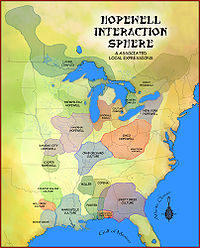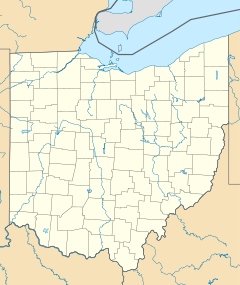- Newark Earthworks
-
Newark Earthworks
 One end of the Great Circle Earthworks, part of the Newark Earthworks.
One end of the Great Circle Earthworks, part of the Newark Earthworks.Location: Roughly bounded by Union, 30th, James, and Waldo Sts., and OH 16, Newark, Ohio Coordinates: 40°2′31.8″N 82°25′48.4″W / 40.042167°N 82.430111°WCoordinates: 40°2′31.8″N 82°25′48.4″W / 40.042167°N 82.430111°W Architectural style: Hopewell culture Governing body: Local and state government[1] NRHP Reference#: 66000614[1] Added to NRHP: October 10, 1966 The Newark Earthworks in Newark and Heath, Ohio, consists of three sections of preserved earthworks: the Great Circle Earthworks, the Octagon Earthworks, and the Wright Earthworks. This complex contained the largest earthen enclosures in the world, being about 3,000 acres in extent. Today, the site itself covers 206 acres. The site is preserved as a state park by the Ohio Historical Society. It has been designated a National Historic Landmark. In 2006, Newark Earthworks was also designated as the "official prehistoric monument of the State of Ohio." [2]
In addition, this is part of the Hopewell Ceremonial Earthworks, one of 14 sites nominated in January 2008 by the Department of Interior for potential submission by the United States to the UNESCO World Heritage List.[2]
Contents
History
Built by the Hopewell culture between 100 BC and AD 500, the earthworks were used as places of ceremony, social gathering, trade, and worship. The Newark Earthwork site is the largest surviving Hopewell earthwork complex. The culture built many earthen mounds. Over many years, they built the single largest earthwork enclosure complex in the Ohio River Valley. The earthworks cover several square miles. Scholars have demonstrated that the Octagon Earthworks comprise a lunar observatory for tracking the moon's orbit during its 18.6-year cycle.
Great Circle Earthworks
The 1,180-foot (360 m) wide Newark Great Circle is the largest circular earthwork in the Americas, at least in construction effort. The 8 feet (2.4 m) high walls surround a 5 feet (1.5 m) deep moat, except at the entrance where the dimensions are even greater and more impressive. Researchers have used archaeogeodesy and archaeoastronomy to analyze the placements, alignments, dimensions, and site-to-site interrelationships of the earthworks. This research has revealed that the prehistoric cultures in the area had advanced scientific understanding as the basis of their complex construction.
Today, the Great Circle Earthworks are preserved in a public park in Heath.
Octagon Earthworks
In 1982 researchers from Earlham College in Richmond, Indiana concluded that the complex was a lunar observatory, designed to track motions of the moon, including the northernmost point of the 18.6-year cycle of the lunar orbit. The moon then rises within one-half of a degree of the octagon's exact center. The earthwork is twice as precise as the complex at Stonehenge (assuming Stonehenge is an observatory, which is a disputed theory).[3]
From 1892 to 1908, the state of Ohio used the Octagon Earthworks as a militia encampment. Immediately after this, the Newark Board of Trade owned the property, until 1918. In 1910, they leased the property to Mound Builders Country Club (MBCC), which developed the site as a golf course. As a result of a Licking County Common Pleas Court case, a trustee was named to manage the property from 1918 to 1933.[3]
In 1997 the Ohio Historical Society signed a lease until 2078 with the country club. MBCC maintains, secures, and provides some public access to the land. Some citizens believe the country club is an inappropriate use of the sacred site. There has been increasing public interest in the earthworks. Activists have pressed for more public access to the site to witness the moonrise, whose observance was planned in the construction by the original native builders.[3]
Observatory Mound, Observatory Circle, and the interconnected Octagon span nearly 3,000 feet (910 m) in length.
Wright Earthworks
Part of Newark Earthworks State Memorial, the Wright Earthworks consist of a fragment of a geometrically near-perfect square enclosure and part of one wall that originally formed a set of parallel embankments, which led from the square to a large oval enclosure.[4]Originally, the sides of the Newark square ranged from about 940 to 950 feet in length, and they enclosed a total area of about 20 acres. [4]Farming and construction associated with building the Ohio Canal and the streets and houses of the city of Newark destroyed much of the square enclosure and its associated mounds.[4] The remaining segment of one wall of the square is less than two hundred feet long. [4]
Nomenclature
The Wright Earthworks are named in honor of Mrs. Frances Rees Wright who donated the site to the Ohio Historical Society in 1934. [4]
See also
- Hopewell Culture National Historical Park
- Fort Ancient
- List of Hopewell sites
- Earthwork (archaeology)
- Mound builder (people)
References
- ^ a b "National Register of Historical Places - Ohio (OH), Licking County". National Register of Historic Places. National Park Service. 2008-01-13. http://www.nationalregisterofhistoricplaces.com/OH/Licking/state.html.
- ^ "Secretary Kempthorne Selects New U.S. World Heritage Tentative List", Dept. of Interior (posted by Octagonmoonrise), 22 Jan 2008, accessed 5 Dec 2008
- ^ a b c Maag, Christopher (2005-11-28). "Ohio Indian Mounds: Hallowed Ground and a Nice Par 3". New York Times. http://www.nytimes.com/2005/11/28/national/28mounds.html.
- ^ a b c d e [1]
External links
- Newark Earthworks
- The Great Circle
- The Great Circle Earthwork, Newark, Ohio
- Octagon Earthworks at Newark, Ohio, a Photo Gallery
- The Wright Earthworks
- The Octagon Earthworks: A Neolithic Lunar Observatory
- Octagon Moonrise.Org
- "Newark Earthworks", Artist hideout
 Hopewellian peoplesWoodland period · List of Hopewell sites · Mound builder (people) · List of archaeological periods (North America)
Hopewellian peoplesWoodland period · List of Hopewell sites · Mound builder (people) · List of archaeological periods (North America)Ohio Hopewell Beam Farm · Benham Mound · Cary Village Site · Cedar-Bank Works · Dunns Pond Mound · Ellis Mounds · Ety Enclosure · Ety Habitation Site · Fort Ancient · Fortified Hill Works · Great Hopewell Road · High Banks Works · Hopeton Earthworks · Hopewell Culture National Historical Park · Indian Mound Cemetery · Keiter Mound · Marietta Earthworks · Moorehead Circle · Mound of Pipes · Nettle Lake Mound Group · Newark Earthworks · Oak Mounds · Perin Village Site · Portsmouth Earthworks · Seip Earthworks and Dill Mounds District · Shawnee Lookout · Tremper Mound and Works · Williamson Mound Archeological District
Crab Orchard culture Goodall Focus Goodall Site · Norton Mound GroupHavana Hopewell culture Kansas City Hopewell Marksville culture Miller culture Point Peninsula Complex Swift Creek culture Etowah Indian Mounds · Leake Mounds · Kolomoki Mounds Historic Park · Miner's Creek site, · Nacoochee Mound · Swift Creek mound site · Yearwood siteOther Hopewellian peoples Armstrong culture · Copena culture · Fourche Maline culture · Laurel Complex · Saugeen Complex · Old Stone Fort (Tennessee)Exotic trade items Related topics · Ancient Monuments of the Mississippi Valley · Black drink · burial mound · Calumet (pipe) · Effigy mound · Hopewell pottery · Horned Serpent · Eastern Agricultural Complex · Underwater pantherU.S. National Register of Historic Places Topics Lists by states Alabama • Alaska • Arizona • Arkansas • California • Colorado • Connecticut • Delaware • Florida • Georgia • Hawaii • Idaho • Illinois • Indiana • Iowa • Kansas • Kentucky • Louisiana • Maine • Maryland • Massachusetts • Michigan • Minnesota • Mississippi • Missouri • Montana • Nebraska • Nevada • New Hampshire • New Jersey • New Mexico • New York • North Carolina • North Dakota • Ohio • Oklahoma • Oregon • Pennsylvania • Rhode Island • South Carolina • South Dakota • Tennessee • Texas • Utah • Vermont • Virginia • Washington • West Virginia • Wisconsin • WyomingLists by territories Lists by associated states Other Categories:- Ohio Hopewell
- Native American archeology
- National Historic Landmarks in Ohio
- Ohio state parks
- Symbols of Ohio
- Land art
- Newark, Ohio
- Ohio Historical Society
- Mounds in the United States
Wikimedia Foundation. 2010.




